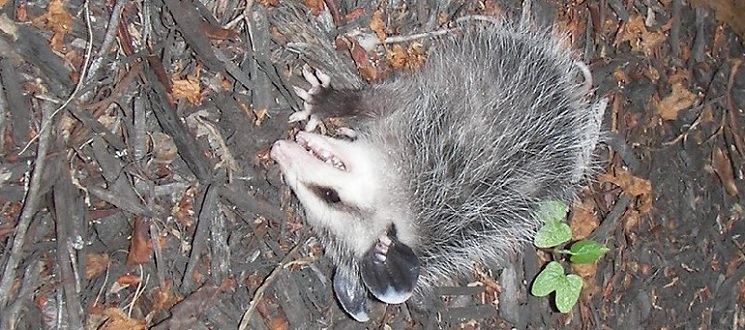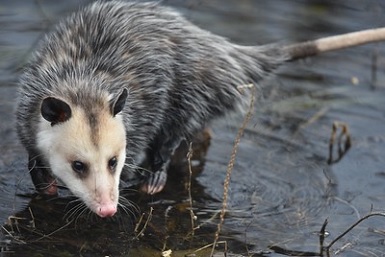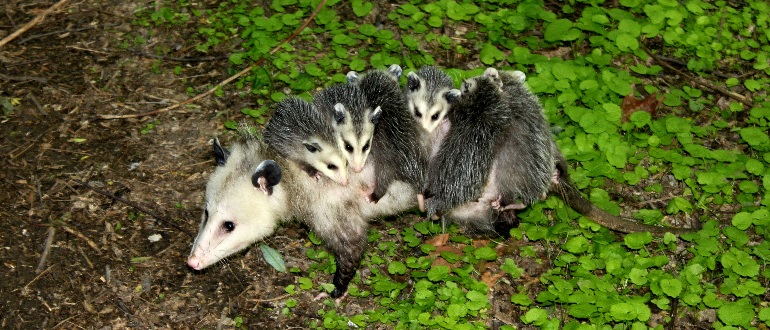Guess who helps fight tick borne disease?
GET TO KNOW
Virginia opossums
Be kind to opossums. They are quiet, shy, intelligent animals that are helpful to humans because they eat a lot of ticks!
FUN FACT: Opossums are adorable. Juvenile opossums ride around on mama’s back while they learn life and survival skills.
Researchers estimate that each individual opossum eats as many as 5,000 ticks per summer. That’s a lot of ticks that won’t bite you! Think of opossums as furry little knights in shining armor defending public health. Michigan ticks are known to carry six diseases including one that mimics COVID-19 symptoms: anaplasmosis, which causes fever, headache, chills, and muscle aches and is on the rise in Michigan.
How do opossums find and eat those 5,000 ticks per summer? They hang out in forests and fields where ticks catch a ride in their fur. Since opossums are clean little animals, they groom themselves meticulously. They do not like ticks in their fur, but they do like ticks on their menu! (Yum?) Opossums also eat grubs, slugs, snails, and decaying debris as they amble about and are an important part of nature’s clean-up crew.
DO OPOSSUMS REALLY PLAY DEAD?

Opossum frozen in “play dead” state.
Photo by Amy CC-BY-2.0
Virginia opossums are well known for “playing dead” when frightened. However, the process is not a voluntary strategy but an involuntary shock response to perceived danger, entering a comatose-like state that can last as long five hours. During this time, the opossum is vulnerable to predators, scavengers, passing cars, family dogs, and homeowners.
If you find an opossum that appears to be dead, gently move it out of any roadways and provide shelter for five or six hours to see if it recovers. Do not bury it right away!
PHYSICAL CHARACTERISTICS
Virginia opossums are mostly gray with a white face, black ears and pink nose. They have long, skinny tails that average about 12 inches long. Adult size varies based on population location. The largest individuals are found in the northern part of range and weigh from 5-15 pounds and are 12-36 inches long (plus the 12-inch tail).
Opossums are good climbers. Since opossum tails are relatively strong and prehensile (able to grip and hold something) they are used for balance and grabbing. Young opossums can even hang by their tails for a very short time. However, the old folktale that opossums sleep hanging upside down in trees is only a myth. These shy little guys hide away to sleep during the day.
HABITAT & LIFE CYCLE

photo by Andy Reago & Chrissy McClarren CC-BY-2.0
While Virginia opossums can survive in suburbia, their preferred natural habitats are wetland areas and deciduous forests with streams. They are solitary night-time wanderers that do not defend personal territories, staying on the move during warm weather and finding temporary shelters in hollow trees, logs, holes, and debris. Since they climb well, they also spend a lot of time up in trees.
Despite a range that stretches into southern Canada, opossums do not tolerate harsh winters well, and have only recently extended their range into Michigan’s Upper Peninsula as the climate has warmed. They do not hibernate and must continue to forage for food throughout the cold months. Some opossums will even join together to share a winter nesting place to keep warm, and many suffer from frostbite or die during extremely cold winters. University of Michigan professor Phil Myers has been studying mammal distribution around the state and documented the dramatic northward migration of opossums over the last 25 years as the climate has warmed.
Opossums have many predators, and most survive only one or two years. Beginning in their second year, females have two litters during the summer. Each litter may produce as many as twenty tiny, blind, and hairless newborns (bumblebee size). Since opossums are marsupials, the newborns must crawl from the birth canal, up the mother’s belly, and into her pouch. Most do not survive the crawl, but a lucky few make it to the safety of the pouch. There, they will nurse and develop for about 2 ½ months. Once developed, juveniles (called joeys) are carried on mama’s back for another 2 ½ months before they are on their own in the big world.
TAKE ACTION
Unfortunately, opossums are threatened by unfriendly human interaction. Too many people think negatively of opossums and kill them. Due to habitat loss, opossums are also endangered by encounters with cars and family dogs.
To help opossums, it is important to be kind to them, to offer protection when they get stuck in the “playing dead” state, and to help FOTR preserve, protect and restore the opossum’s watershed home.
MAIN PHOTO CREDIT: Virginia opossum (Didelphis virginiana) mama with six babies in Hines Park in 2016. Photo by P. Stark – image cropped
